Website Conversion Audit: 12 Things Killing Your D2C Conversions Today
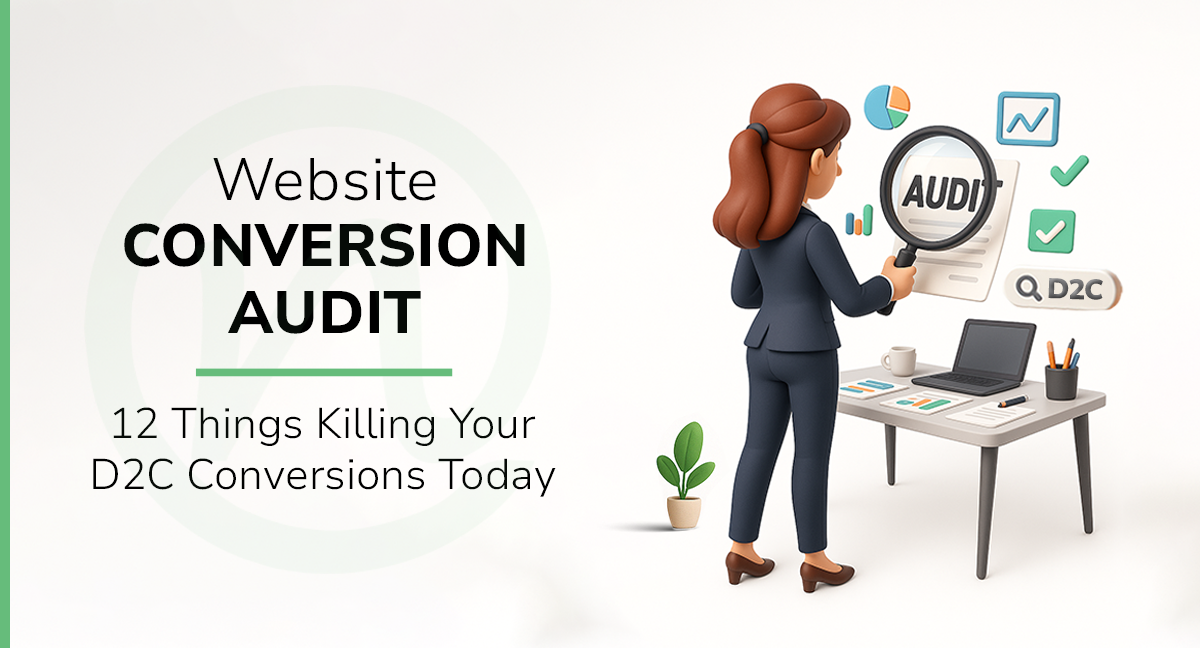
15th May 2025 / in SEO / by Ruturaj Kohok
- Reading time: 11 mins 02 Sec
Is your D2C website turning visitors into customers? Or are they just… leaving?
We’ve seen it happen countless times – you put all that effort into your marketing campaigns to drive traffic to your site, but visitors simply don’t convert. Why do you think it happens?
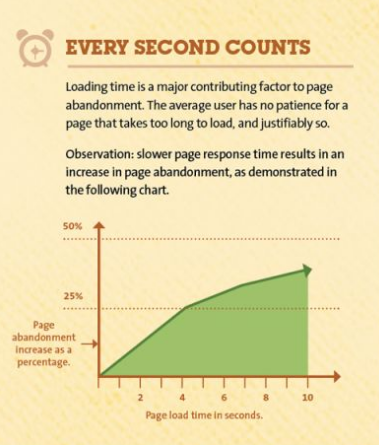
Source: We Make Websites
Check this out: As your page load time increases, your cart abandonment rate also increases. That’s conversions dropping while your page is still loading!
We understand the frustration. You’ve invested heavily in building a site with attractive content, but somewhere along the way, critical conversion issues got overlooked.
While the average e-commerce website conversion rate hovers around 2-3%, many D2C brands struggle to hit even these modest numbers, and it’s usually because of problems that are actually pretty easy to fix.
Let’s get into what they are!
12 most common conversion killers for your D2C brand:
We have curated a list of factors that hinder your conversions, but here’s the good news: these problems can EASILY be managed!
All you need to do is keep an eye out for these and solve them as they arise.
Let’s begin –
#1 Slow Load Times
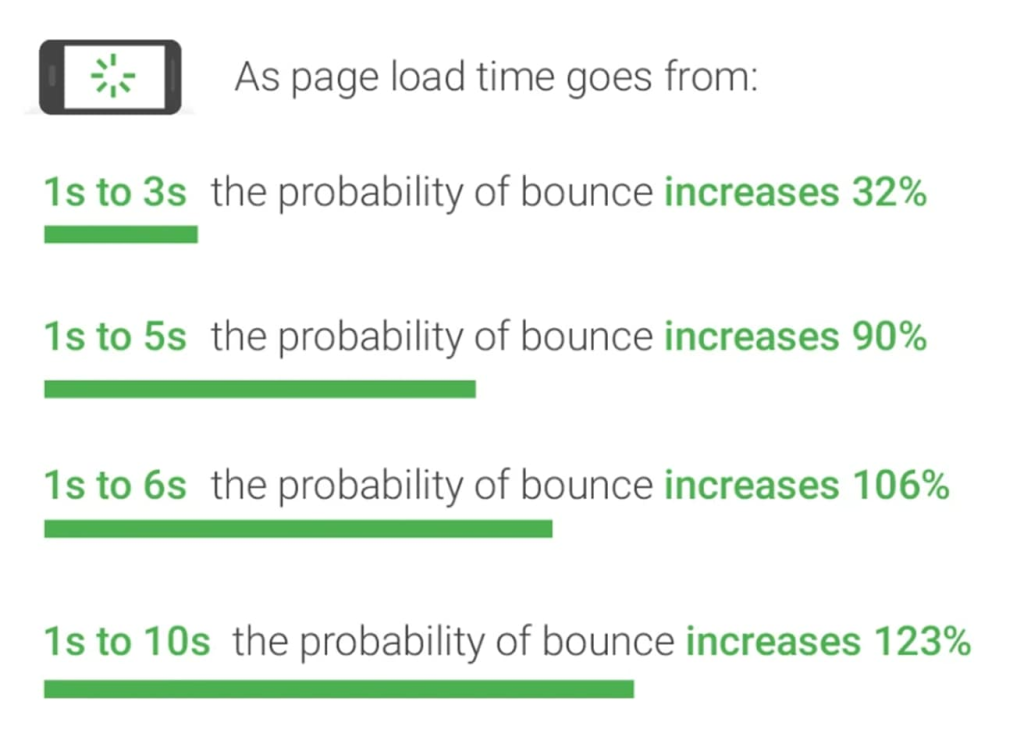
Source: Queue-it
You work so hard on your marketing campaigns to bring potential customers to your site. But what happens? They disappear before even seeing your products!
Why does this happen? As page load time crawls from 1 second to 3 seconds, the probability of bounce shoots up by 32%. If it takes up to 5 seconds, the probability of bounce rate goes up to 90%.
If it takes an additional 1 more second, the bounce rate rises to 106%, while if your D2C e-commerce site takes about 10 seconds to load, the bounce rate is around 123%.
The connection between speed and sales couldn’t be any clearer.
And mobile shoppers? They’re even less patient! If your D2C brand hasn’t optimized for mobile speed, you’re losing serious revenue.
We understand that keeping up with consumer expectations is tough.
Building a site with excellent speed starts with measuring what you’ve got. After you’ve identified the issues, focus on optimising images, enabling browser caching, minimising CSS and JavaScript, and implementing a content delivery network (CDN).
Many D2C brands have seen amazing results with these website solutions.
Remember that Google now factors page speed into both search rankings and ad quality scores.
Slow landing pages drag down your Google Ads Quality Score, which means you’ll pay more per click.
Your brand strategies should make speed optimisation a top priority – it directly impacts user experience, SEO, and ultimately, your conversions.
#2 Not optimising for mobiles
Let’s be real, mobile-first design is a fundamental shift in building a site.
Instead of creating a beautiful desktop site and then cramming it into a smartphone screen, you start with mobile and scale up.
Did you know Google now uses mobile-first indexing? This means mobile-friendly websites appear higher in search results.
No wonder those desktop-first sites with their crowded layouts and missing elements on smartphones are seeing fewer and fewer visitors!

Source: Wiser Notify
Did you know? 57% of people won’t recommend a business with a poorly designed mobile site.
When brands implement mobile-first design, they see dramatic improvements in their website conversion rate, and it makes perfect sense.
A mobile-first approach forces you to focus on what’s truly essential, creating a cleaner, more focused experience across all devices.
To improve your mobile experience, make sure your site is responsive with clear navigation and properly sized buttons.
Unlike desktop design, mobile requires streamlined payment options and simplified content that fits smaller screens without requiring zooming.
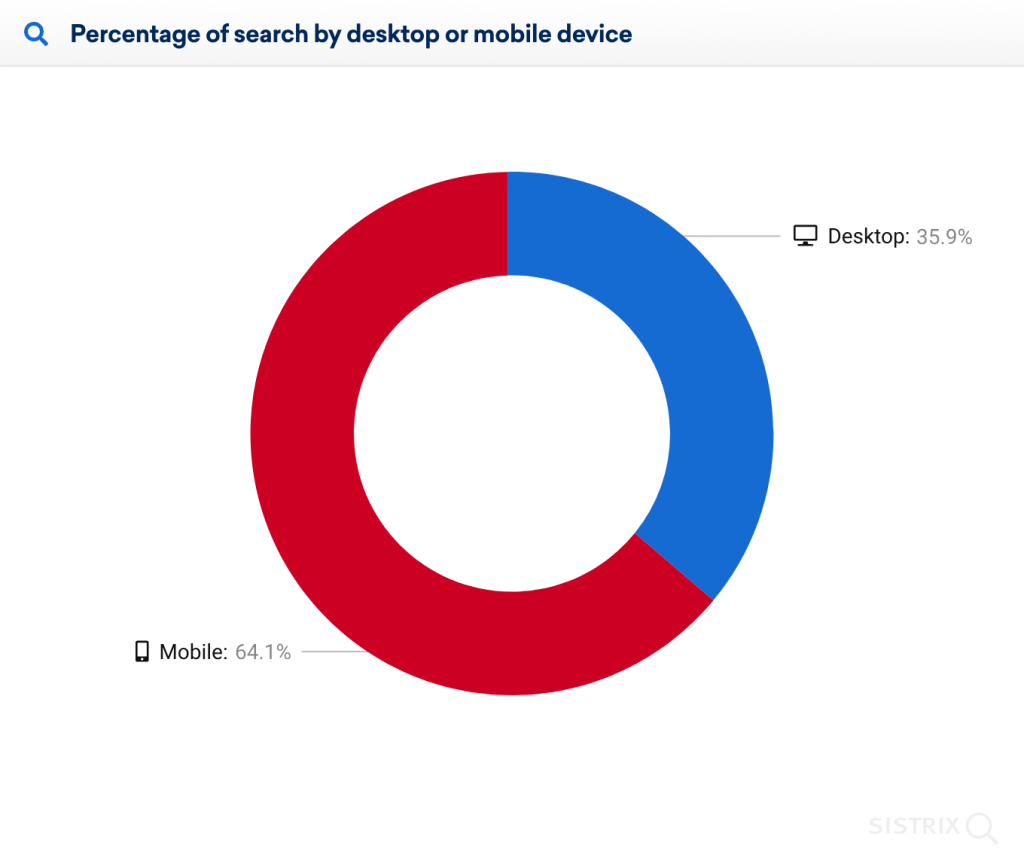
Source: Sistrix
With 64% of research now happening on mobile phones, investing in mobile optimisation isn’t optional – it’s essential for your marketing campaigns and brand strategies.
After all, if your mobile experience is broken, your conversions will be too!
#3 Confusing Navigation
Ever feel like you’re wandering in a maze when shopping online? You’re not alone!
This confusion isn’t just annoying – it directly translates to lost sales. When shoppers can’t easily find what they’re looking for, they make assumptions that hurt your business long-term.
Often, if users can’t locate a product, they don’t think “this website is confusing” – they think “this store doesn’t sell what I need”.
And just like that, you’ve lost not just one sale but potentially a lifetime customer.
Navigation isn’t just about making your site user-friendly. It also affects your SEO in a big way.
A logical structure helps search engines discover and index all your pages, potentially boosting your visibility in search results.
When you create intuitive navigation, you’ll see bounce rates drop, site visits get longer, and conversion rates climb across all your marketing campaigns. And that’s what we all want, right?
#4 Weak Product Pages
Product pages are where the magic happens – it’s the critical moment when browsers decide whether to become buyers.
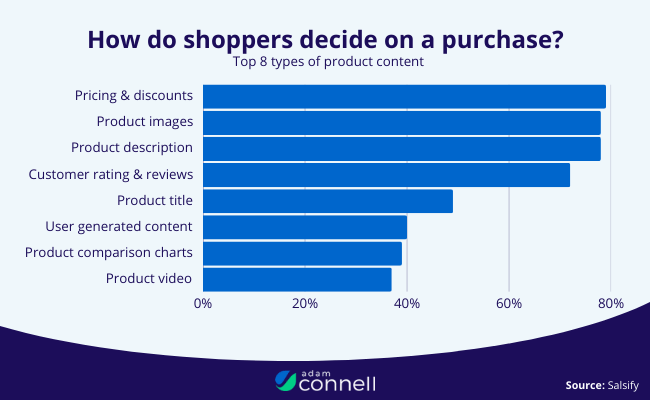
Source: Adam Connell
Check this out: when deciding whether or not to purchase, almost 80% of users check the pricing, discounts, product images and product descriptions.
A little over 70% of people also check the ratings and reviews on the product page, while almost 50% check the product titles.
#5 Complicated checkout process
Remember this: Every additional field you add to your checkout form increases the likelihood of abandonment.
Ideally, e-commerce websites only need eight form fields, yet an average website has almost twelve. This gap creates needless friction.
To optimise your checkout and boost your website conversion rate, stick to essentials like name, shipping address, and payment details.
Also, implement autofill and smart form-filling capabilities to speed things up, create a single-page checkout when possible, and offer multiple payment methods.
Building a site with minimal checkout friction means prioritising speed and simplicity over data collection.
Remember – your checkout page isn’t the place for marketing or brand strategies. It’s where you make completing a purchase as easy and convenient as possible!
#6 Lack of credibility
You know what’s at the heart of every successful online sale? Trust. Plain and simple.
Research reveals that the most common trust issue causing cart abandonment is concern about business legitimacy.
When shoppers feel even a tiny bit unsure about your D2C brand’s credibility, they go poof! They’re gone before you can say “checkout complete.”

Source: Baymard
Check this out: 70% of shopping carts are abandoned, with 19% directly due to security concerns. Just by eliminating these worries, you could instantly boost your sales!
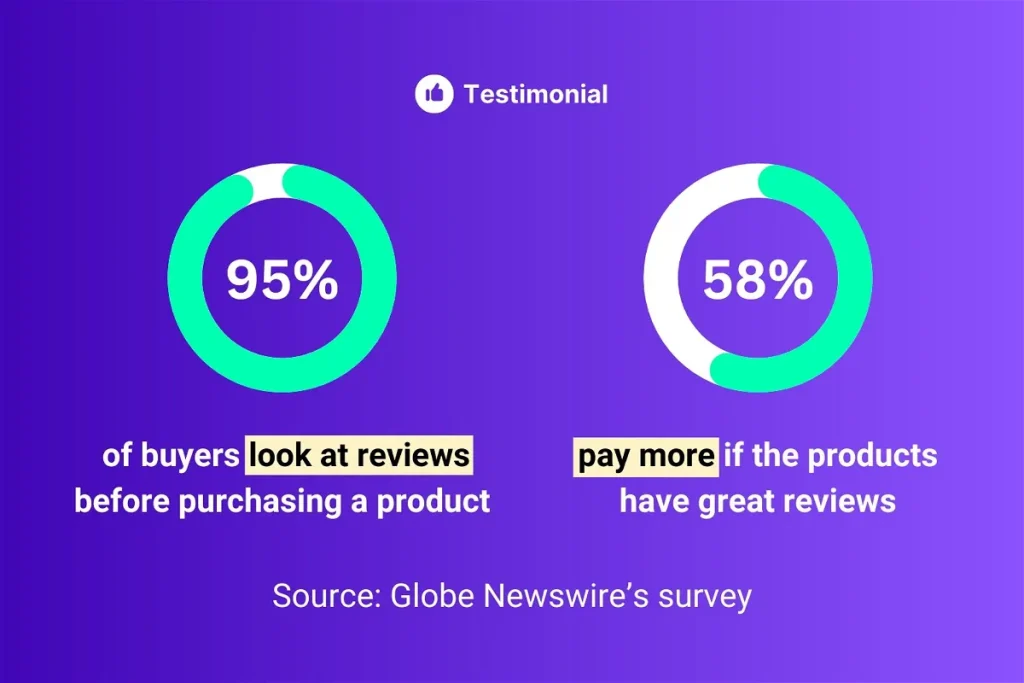
Source: Wisernotify
Did you know 95% of customers make purchase decisions only after reading reviews from other customers? That’s HUGE! And 58% of consumers would pay more if the product has favourable reviews.
When building a D2C brand from scratch, website content can build trust and credibility through long-form content, implementing organic activities, and being transparent about your process and values.
Other than security and reviews, you can strategically place trust signals to gain credibility.
Your checkout page needs security badges front and centre – that’s where shoppers get cold feet about entering their payment details.
But don’t hide your return policy in some tiny footer link – make it easily accessible throughout your site.
Remember – transparency builds long-term relationships. A clear refund process builds trust and confidence in your brand.
Without proper trust signals, even the best website solutions will fall flat, and your strategies won’t convert those interested browsers into loyal, paying customers.
#7 Misaligned CTAs
Now, where you put your CTAs makes a HUGE difference in whether people click them or not.
Visual prominence is super important. Have you ever tried to tap a tiny button on your phone and kept missing it? Frustrating, right?
That’s why whitespace around your CTA button significantly increases its visibility and clickability.
And colour matters! Use contrasting colours that make your buttons pop off the page.
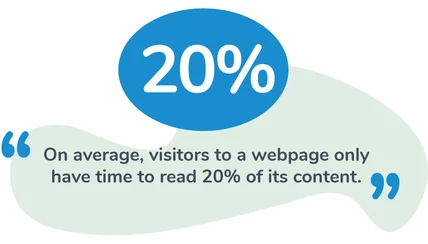
Source: DemandJump
Remember to keep your button text short and sweet – between two to five words is ideal, because visitors only read about 20% of your page content!
#8 Not making data-based decisions
Want to transform your optimisation efforts? You need to know the metrics actually matter.
But you need to go beyond the basics by segmenting your data for deeper insights. For this, you can go for A/B testing in your marketing campaigns.
We’ve seen many brands make common A/B testing mistakes – ending tests too early, testing too many elements at once, or ignoring seasonal variations.
But even with these challenges, the results can be amazing! Remember, optimisation isn’t a one-and-done deal – it’s an ongoing process.
With the competitive nature of e commerce today, regular testing should be fused into your brand strategies and website from day one.
#9 Content is not compelling enough
Have you ever browsed a beautifully designed website but still left without buying anything? It happens ALL THE TIME.
This is because your visitors might find your store visually appealing, but if they don’t have the information they need to make confident purchasing decisions, they’ll bounce right off!
Listen, good content does waaay more than just fill space on your pages. It’s the difference between a browser and a buyer.
Content marketing builds trust with your potential customers – the kind of trust that pushes them to complete their purchase instead of abandoning their cart.
Good content also answers your customers’ questions before they even need to ask.
When shoppers find all the information they need right there on your page, they feel more confident hitting that “Buy Now” button.
#10 Ignoring internal search
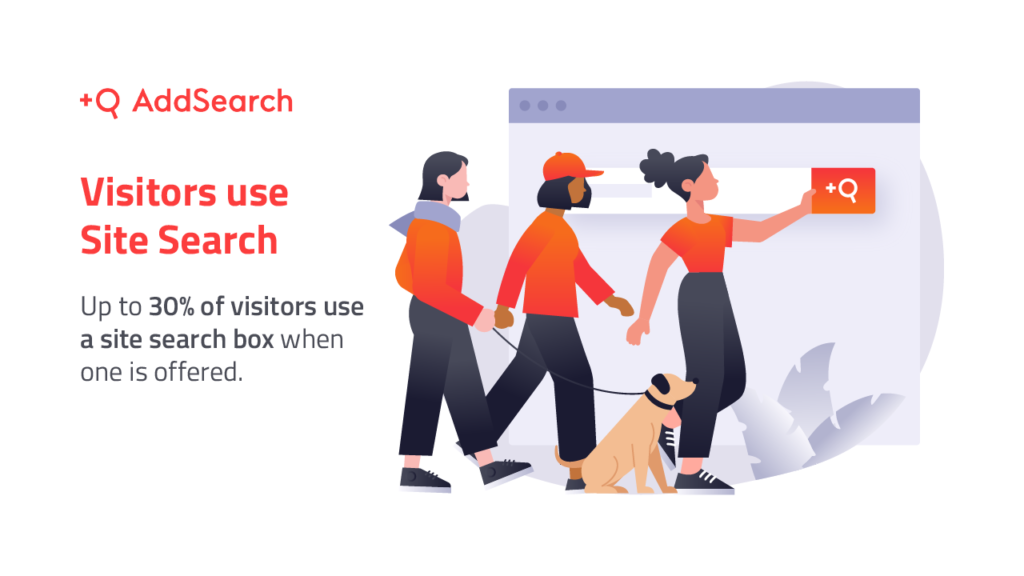
Source: Addsearch
30% of your visitors will use your site’s search function, and these aren’t casual browsers. These are motivated shoppers who know exactly what they want!
Here’s the kicker – when these high-intent visitors hit a difficulty with your search function, they don’t stick around browsing your categories. They just… leave.
And what about those dreaded “no results” pages? They’re basically conversion killers!
Every time a customer types “blue sofa” when you’ve categorised items as “blue couch,” you’re losing a sale. All because of simple synonym mismatches and spelling errors in your website content!
The good news? You don’t need to completely overhaul your website to fix these issues. We understand that rebuilding a site from scratch isn’t practical.
Instead, focus on these high-impact improvements:
- Add autocomplete and predictive text to guide shoppers toward results
- Include synonym recognition (so “couch” finds “sofa” too)
- Enable fuzzy matching to handle those inevitable typos
- Consider visual search if you sell fashion or home décor items
- Personalise search results based on browsing history
Don’t forget to regularly analyse your search data! What customers search for gives you amazing insights into what they actually want.
This information can guide your marketing and content strategy in powerful ways.
For maximum impact on your website conversion rate, make sure your search results page includes product thumbnails, prices, availability info, and quick-add buttons.
This combo of visual information and direct action options creates the smoothest path to purchase.
#11 Missing out on retargeting
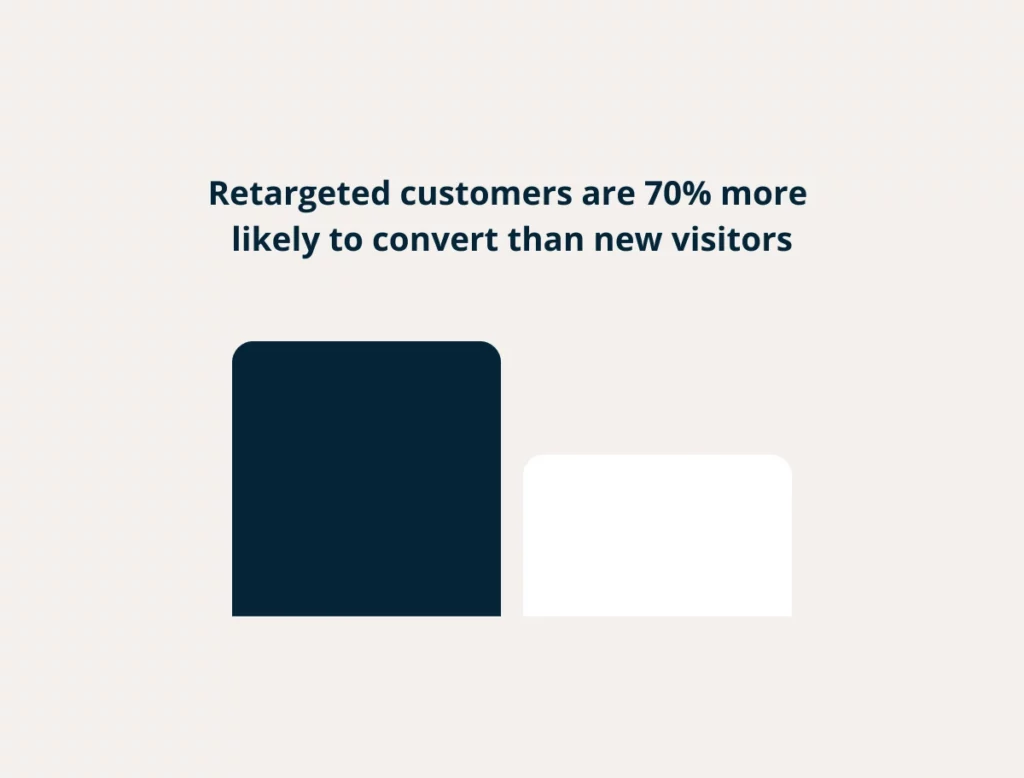
Source: DemandJump
Did you know retargeted visitors are 70% more likely to convert than those who aren’t retargeted? That’s not all – retargeting can boost your website conversion rate by up to 150% in certain industries!
It’s because you’re reaching people who already know your brand. These warm leads need less convincing than cold prospects – they’ve already shown interest!
Second, retargeting costs less than finding new traffic. The average cost-per-click for retargeting ads is 2-3 times lower than standard display ads.
When it comes to recovering lost sales, abandoned cart emails are absolutely golden. A well-crafted email sequence can recover up to 10-15% of otherwise lost revenue.
When doing so, make sure everything looks great on mobile – most people check emails on their phones.
We understand the importance of a comprehensive approach – your brand strategies should include multiple touchpoints.
Combining email retargeting with social media and display ads improves your chances of bringing those lost visitors back to complete their purchase.
#12 Not personalising customer experiences
Let’s be real – generic, one-size-fits-all experiences are killing your D2C conversions.
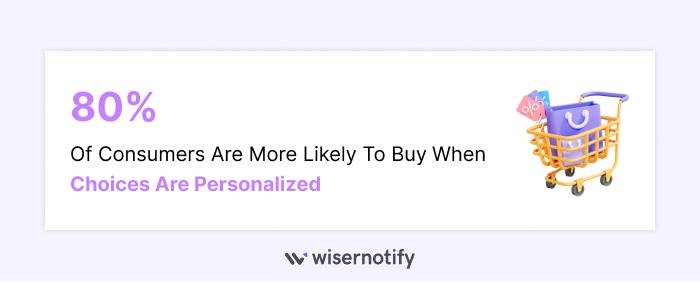
Source: Wiser Notify
Did you know that 80% of shoppers are more likely to purchase from companies offering personalised experiences?
Yet so many online stores keep showing identical content to every visitor, regardless of their unique interests.
Here’s what’s happening: Your visitors are leaving digital footprints all over your site – clicking, browsing, lingering – and these footprints are gold mines for personalisation.
These browsing patterns reveal what your customers actually want far better than basic demographic data; the impact of personalisation on D2C business models is huge!
We understand it can seem overwhelming, but implementing personalisation doesn’t have to be complicated. Several D2C brands are absolutely crushing it with personalisation.
Remember that the best personalisation feels helpful, not creepy. You want your website content and strategies to create experiences that feel like a thoughtful store assistant!
As customers increasingly expect tailored experiences, personalisation has gone from “nice-to-have” to “must-have” for any D2C brand serious about conversions.
Final thoughts: Mastering D2C Conversion Starts with a Strategic Audit
After going through these 12 conversion killers, the path to better D2C website conversion rates is pretty clear! Even small tweaks can make a HUGE difference to your bottom line.
We understand that conversion optimisation requires attention to detail, but trust us – the rewards far outweigh the effort.
By fixing these common conversion killers, you’ll transform your D2C website from a boring digital brochure into a revenue-generating machine that turns those casual browsers into loyal, paying customers.
At Nethority, we specialise in helping D2C brands overcome these exact challenges.
FAQs:
A D2C website conversion audit is a detailed analysis of your website to identify why your visitors don’t convert to customers. It includes a comprehensive review of your website design, content, UX, and performance. It can help you identify both technical issues and user behaviour.
Focus on your website’s loading time, offer clear CTAs, make navigation easy, optimise for mobile devices, and offer personalised experiences to improve your website’s conversion rates. Other than that, continuous testing, data analysis, and a clear focus on user experience are crucial in achieving better conversion rates.
Mobile optimisation plays a key role in conversions as it ensures that your website loads fast, aligns with all screen sizes, and functions smoothly on mobile phones. It can avoid friction and offer a seamless experience to users that can ultimately aid in conversions.
Ideally, you should conduct a conversion audit at least every quarter or after every campaign, product launch, or design change to stay on top of evolving user behaviour and to improve performance by making data-based decisions.
Offering multiple payment options can make the purchase journey convenient for most users for their payment preferences such as UPI, credit/debit cards, wallets, and more. This can lower the cart abandonment rates and improve conversion rates.





























